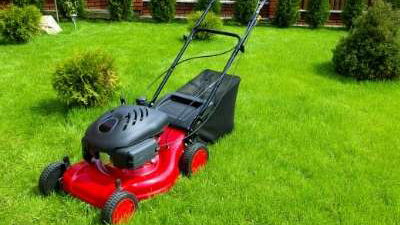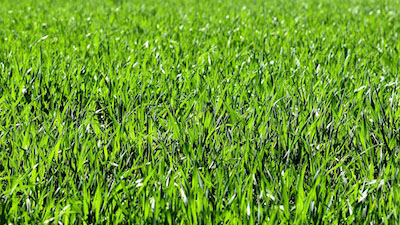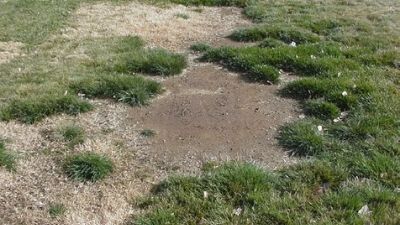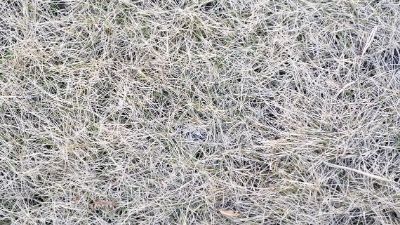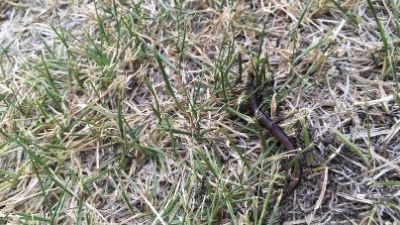Lawn Fertilizers for Cool Season Turf
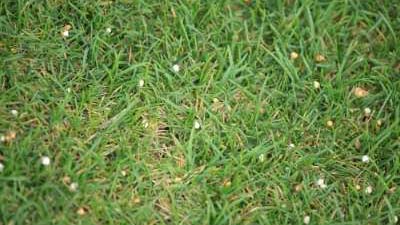
Introduction
Lawns provide a durable and functional surface for many outdoor activities while adding beauty to the landscape. For these reasons, a healthy, green lawn is the goal of many homeowners and landscape managers. Keeping a lawn healthy and green may require many management practices such as mowing, irrigation and aerification. Often, these practices will include fertilizing with supplemental nutrients at various times during the growing season. This promotes optimum turf color, improves re-growth, and increases tolerance to wear, drought, insects and disease. The broad number of fertilizer options available from retailers can make choosing a fertilizer difficult. However, choosing an appropriate fertilizer and fertilization schedule can be simplified by determining turf nutrient needs through soil testing and determining how the turf will be used.
Fertilizer Recommendations
To make the best possible fertilizer recommendations, USU Cooperative Extension assumes the following:
- Inexpensive soil testing occurs at least once every 3 years.
- Grass is mowed to a height of 2½ to 4 inches.
- Most lawn clippings are mulched back into the lawn [because nitrogen (N) fertilization can be reduced by up to 50% when grass clippings are returned to the lawn (Kopp and Guillard, 2002)].
- Turf is irrigated correctly to minimize water loss and leaching of fertilizer (For more information about irrigating turf in Utah access the Utah Division of Water Resources lawn watering guide at: http://tinyurl.com/irrigatelawn.).
Determining Lawn Fertilizer Needs
There are two important factors in choosing an appropriate fertilizer blend for turf. These are testing to determine existing nutrient levels in the soil and determining how the turf will be used.
Soil Testing
Soil testing determines which nutrients are available in the soil and is an important factor in determining which fertilizer blend to use on lawns. A routine soil test from the USU Analytical Laboratory (USUAL) is inexpensive (go to www.usual.usu.edu for current pricing) and will provide a great deal of useful information.
- A soil test report records many soil characteristics including soil texture, alkalinity (pH), and salinity. In the sample soil test report below (Figure 1), the following characteristics are noted:
- Soil texture (loam): Loam soils have many good characteristics.
- pH (7.46):Alkaline soils are very common in Utah.
- Salinity (1.33 dS/m): This level is acceptable for growing cool season turf.
- Nitrogen:Nitrogen levels are not given here. Nitrogen is highly dynamic in the soil, and it is assumed that the soil will require at least annual additions of N (James and Topper, 2003).
- Phosphorus (P, 80 mg/kg) and potassium (K, 507 mg/kg): Levels are measured as high and very high, respectively. If the soil were deficient in either, application recommendations would be in the form of the compounds P2O5 (phosphate) and K2O (potash). The amount to apply is given in pounds per thousand square feet per year (lbs/1,000 ft2 /year). These compounds are the standard sources for P and K in lawn fertilizer blends.
Of the three major plant nutrients discussed above (N, P and K), turfgrasses in Utah most often require N application, while rarely requiring additions of phosphate or potash. Nevertheless, testing is always warranted to be sure. These measures show that this particular soil needs a fertilizer containing N only.
For further information about soil testing and interpreting a soil test report, access the USUAL fact sheet entitled Understanding Your Soil Test: http://tinyurl.com/ususoiltest. The USUAL recommends retesting soil every 2 to 3 years.
Determining Turf Use
As previously mentioned, lawns provide a durable and functional surface for many outdoor activities while adding beauty to the landscape. When used appropriately, turf out competes weeds and provides a soft, durable surface useful for many activities. However, how much and how often turf is used greatly impacts how often fertilizer applications are needed to maintain its health. For example, some lawns receive little use and may only see traffic when they are mowed. These lawns require little fertilizer to maintain them. Conversely, other turf areas may receive traffic from children’s play, garden parties or sports. These lawns may require multiple fertilizer applications throughout the growing season to keep them healthy. In general, though, turf use can be divided into three categories: heavy use, moderate use and light use. These categories may be further defined as follows:
- Heavy Use: Frequently used sports field play, heavy traffic and/or frequent garden parties.
- Moderate use: Typical children’s play and/or occasional garden parties.
- Light Use: Occasional foot traffic or little to no play from children.
Most home lawns fall into either the moderate or light use category.
Understanding Fertilizer Labels
Once soil has been tested and lawn use has been determined, the next step is to select an appropriate fertilizer blend. Fortunately, all fertilizers are required to prominently display a three number formula (Figure 2) on their packages. These numbers are the percentages (by weight) of N, phosphate (P2O5) and potash (K2O). For example, a lawn fertilizer with an analysis of 24-5-10 contains 25% N, 5% phosphate and 10% potash. This means a 50 lb bag of this particular product contains 12 pounds of N, 2½ lbs of phosphate, and 5 lbs of potash. All three nutrients are involved in many physiological processes of plants. The rest of the weight of the fertilizer is made up of other elements such as carbon, hydrogen, and oxygen within these compounds.
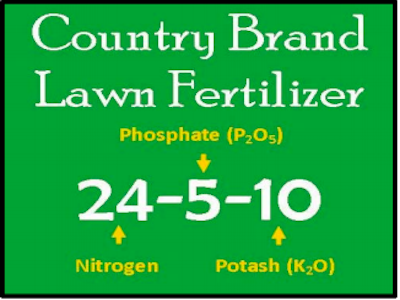
An example of a typical lawn fertilizer label.
In the sample soil test results above indicates that the turf will only be deficient in N. For this reason, a fertilizer with an analysis such as 20-0-0 (where the two zeros show that there is no phosphate or potash in the blend) would be appropriate to use.
Fertilization Frequency and Timing
A fertilization schedule for cool season turf grown in Utah will depend on use level. Fertilization schedules for light, moderate and heavy use turf areas are described below (Table 1).
Note that mid-summer applications are generally discouraged except for heavily used turf, and then only in smaller amounts. This is primarily because of the slowed growth rates of cool-season grasses such as Kentucky bluegrass and fescues during the hottest part of the growing season (Chart 1). In fact, over-fertilization at this time promotes weed growth over turf growth and can cause grass to become drought stressed due to over-stimulation of top growth. If fertilization is undertaken in midsummer, a slow release fertilizer is the best choice.
Additionally, application rates are given in pounds of N per thousand square feet. Fortunately, most lawn fertilizers marketed to consumers contain instructions on how much to apply per thousand square feet. These instructions are usually correct and can be used as a guide.
Nitrogen Fertilizer Products
The source of N within different fertilizer blends varies, with the most common sources being ammonium sulfate [(NH4)2SO4] and urea [(NH2)2CO]. These two forms are released relatively quickly, lasting 4 to 6 weeks, but make N immediately available to plants. Some other sources include slow release forms of N – where N is released over a period of 8 to 12 weeks once applied. Currently the vast majority of these fertilizers are coated urea products.
Slow release forms of N fertilizer reduce leaching of nutrients from the soil, and can also reduce the amount of mowing over time because quick flushes of growth do not occur. Slow release N is especially important to use if applications are needed during the hottest times of the year. Organic sources of N are also available including products made from plant and animal sources. A common animal source is fish meal. Plant sources include cotton meal and soy products. Table 2 gives further details about various fertilizer sources.


Chart 1. Typical growth rate of cool season turfgrass during the growing season. Note that recommended fertilizer application times in Table 1 correspond to growth rates peaks.
Table 2. Common Sources and Forms of Nitrogen in Fertilizers.
| Common Name | Nitrogen (%) | Chemical Formula | Comments |
|---|---|---|---|
| Urea | 46 | (NH2)2CO | Common in liquid and dry formulations. Use caution due to potential plant damage if overapplied. |
| Ammonium Sulfate (AS) | 21 | (NH4)2SO4 | Popular, economical N source. Less potential for damage if accidently over-applied. |
| Slow Release | Varies by blend | Varies | Several forms available. For the lawn care market, slow release fertilizers are usually types of coated urea. Different coatings include sulfur (SCU), plastic or poly coatings (PCU), and poly-sulfur coated urea (PSCU). In many slow release blends, the coated products are mixed with a non-coated, faster releasing form of N such as urea or AS. |
| Organic Fertilizer (OF) | 2-12 depending on source | Varies | Several types available. N sources include composted manure, plant matter such as cotton meal, even processed fish byproducts and even sewage sludge. Nitrogen content is commonly lower than synthetic fertilizers. Soil microorganisms must breakdown OF so N can be released, making OF slow-release. An additional benefit is that organic matter is released back into the soil by these. |
Further Resources
For further information concerning turfgrass care access the following fact sheets:
- Utah Residential Lawn Watering Guide: http://tinyurl.com/watercheck
- Basic Turfgrass Care: http://extension.usu.edu/files/publications/publication/HG_517.pdf
- Turfgrass Cultivation (Aeration): http://extension.usu.edu/files/publications/pu blication/HG_Turf_2006-02.pdf
- Waterwise Landscaping: Practical Turfgrass Areas: http://extension.usu.edu/files/publications/pu blication/HG_Turf_2006-01.pdf
- Irrigation System Maintenance: http://extension.usu.edu/files/publications/factsheet/HG_Irrigation_2004-01.pdf
- Turf Grass Cultivars For Utah: http://extension.usu.edu/files/publications/publication/HG_Grass_2004_01.pdf
References
- Biran, I., B. Bravdo, I. Bushkin-Harav ,and E. Rawitz. 1981. Water consumption and growth rate of 11 turfgrasses as affected by mowing height, irrigation frequency, and soil moisture. Agronomy Journal. 73(1):75-80.
- Harrison, C. 1934. Responses of Kentucky bluegrass to variations in temperature, light, cutting and fertilizing. Plant Physiology. 9(1): 83-106.
- James, D., and K. Topper. 2003. Utah Fertilizer Guide. Utah State University Extension, Logan UT, 84322. Available online at: http://extension.usu.edu/files/publications/publicatio n/AG_431.pdf.
- Kopp, K., and K. Guillard. 2002. Clipping management and nitrogen fertilization of turfgrass: growth, nitrogen utilization and quality. Crop Science. 42:1225-1231.
- Law, N., L. Band, and M. Grove. 2004. Nitrogen input from lawn care practices in suburban watersheds in Baltimore County, MD. Journal of Environmental Planning and Management. 47(5):737-755.
- Morton, G., A. Gold, and M. Sullivan. 1988. Influence of overwatering and fertilization on nitrogen losses from home lawns. Journal of Environmental Quality. 17:124-130.
Utah State University Extension
Peer-reviewed fact sheet
Download PDF
Authors
Taun Beddes and Kelly Kopp
Related Research




